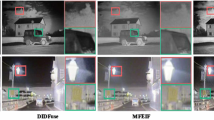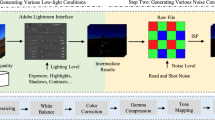Abstract
In the field of low-light image enhancement, existing deep learning methods face three significant challenges: inaccurate reflection component estimation, poor image enhancement capabilities, and high computational costs. This study introduces a novel, efficient solution to these problems in the form of an Ultra-Lightweight Enhancement Network (ULENet). Our primary contributions are twofold. First, we propose the combination of channel-wise context mining and spatial-wise reinforcement for improved low-light image enhancement. Second, we introduce a novel lightweight neural architecture, ULENet, designed specifically for this purpose. ULENet features two innovative subnetworks: the channel-wise context mining subnetwork for extracting rich context from low-light images, and the spatial-wise reinforcement subnetwork for extensive spatial feature extraction and detail reconstruction. We use the deep-learning framework PyTorch for training and evaluating our model. Extensive experiments demonstrate that ULENet significantly outperforms nine state-of-the-art low-light enhancement methods in terms of speed, accuracy, and adaptability in complex low-light scenarios. These results validate our initial hypothesis and underscore the effectiveness of the proposed approach.





Similar content being viewed by others
Data availibility
The code of this study is available from the corresponding author on request.
References
Li C, Guo C, Han L et al (2021) Low-light image and video enhancement using deep learning: a survey. IEEE Trans Pattern Anal Mach Intell 44(12):9396–9416
Liu YF, Guo JM, Lai BS et al (2013) High efficient contrast enhancement using parametric approximation. In 2013 IEEE International Conference on Acoustics, Speech and Signal Processing, pp. 2444–2448. IEEE
Lee C, Lee C, Kim CS (2013) Contrast enhancement based on layered difference representation of 2D histograms. IEEE Trans Image Process 22(12):5372–5384
Wang Q, Ward RK (2007) Fast image/video contrast enhancement based on weighted thresholded histogram equalization. IEEE Trans Consum Electron 53(2):757–764
Jobson DJ, Rahman Z, Woodell GA (1997) Properties and performance of a center/surround retinex. IEEE Trans Image Process 6(3):451–462. https://doi.org/10.1109/83.585790
Rahman Z, Jobson DJ, Woodell GA (1996) Multi-scale retinex for color image enhancement. In Proc. of 3rd IEEE international conf. on image processing. Vol. 3. IEEE
Lee CH, Shih JL, Lien CC et al (2013) Adaptive multiscale retinex for image contrast enhancement. In 2013 International Conference on Signal-Image Technology and Internet-Based Systems, pp. 45–50, IEEE
Wang S, Zheng J, Hu HM et al (2013) Naturalness preserved enhancement algorithm for non-uniform illumination images. IEEE Trans Image Process 22(9):3538–3548
Fu X, Liao Y, Zeng D et al (2015) A probabilistic method for image enhancement with simultaneous illumination and reflectance estimation. IEEE Trans Image Process 24(12):4965–4977
Tao L, Zhu C, Xiang G et al (2017) LLCNN: a convolutional neural network for low-light image enhancement. 2017 IEEE Visual Communications and Image Processing (VCIP). IEEE
Lore KG, Akintayo A, Sarkar S et al (2017) LLNet: a deep autoencoder approach to natural low-light image enhancement. Pattern Recognit 61:650–662
Lv F, Lu F, Wu J et al (2018) MBLLEN: Low-light image/video enhancement using CNNs. In BMVC 220(1)
Cai J, Gu S, Zhang L (2018) Learning a deep single image contrast enhancer from multi-exposure images. IEEE Trans Image Process 27(4):2049–2062
Wei C, Wang W, Yang W et al (2018) Deep retinex decomposition for low-light enhancement. arXiv preprint arXiv:1808.04560
Zhang Y, Zhang J, Guo X (2019) Kindling the darkness: A practical low-light image enhancer. In Proceedings of the 27th ACM international conference on multimedia., pp. 1632–1640
Liu R, Ma L, Zhang J, et al. (2021) Retinex-inspired unrolling with cooperative prior architecture search for low-light image enhancement. In Proc IEEE/CVF Conf Comput Vis Pattern Recognit, pp. 10561–10570
Jain DK, Jacob S, Alzubi J, Menon V (2019) An efficient and adaptable multimedia system for converting PAL to VGA in real-time video processing. J Real-Time Image Proc. https://doi.org/10.1007/s11554-019-00889-4
Hamdoun H, Nazir S, Alzubi JA, Laskot P, Alzubi OA (2020) Performance benefits of network coding for HEVC video communications in satellite networks. Iran J Electr Electron Eng 17:3
Al-Najdawi N, Tedmori S, Alzubi OA, Dorgham O, Alzubi JA (2016) A frequency based hierarchical fast search block matching algorithm for fast video video communications. Int J Adv Comput Sci Appl 7:4
Liu J, Xu D, Yang W et al (2021) Benchmarking low-light image enhancement and beyond. Int J Comput Vis 129(4):1153–1184
Movassagh AA, Alzubi JA, Gheisari M, Rahimi M, Mohan SK, Abbasi AA, Nabipour N (2020) Artificial neural networks training algorithm integrating invasive weed optimization with differential evolutionary model. J Ambient Intell Hum Comput. https://doi.org/10.1007/s12652-020-02623-6
Alzubi OA, Alzubi JA, Al-Zoubi AM, Hassonah MA, Kose U (2021) An efficient malware detection approach with feature weighting based on Harris Hawks optimization. Clust Comput. https://doi.org/10.1007/s10586-021-03459-1
Celik T, Tjahjadi T (2011) Contextual and variational contrast enhancement. IEEE Trans Image Process 20(12):3431–3441
Abdullah-Al-Wadud M et al (2007) A dynamic histogram equalization for image contrast enhancement. IEEE Trans Consum Electron 53(2):593–600
Ibrahim H, Kong NSP (2007) Brightness preserving dynamic histogram equalization for image contrast enhancement. IEEE Trans Consum Electron 53(4):1752–1758
Ying Z et al (2017) A new low-light image enhancement algorithm using camera response model. In Proc. IEEE/CVF Conf. Comput. Vis, Pattern Recognit workshops
Ying Z, Li G, Gao W (2017) A bio-inspired multi-exposure fusion framework for low-light image enhancement. arXiv preprint: arXiv:1711.00591
Fu X, Zeng D, Huang Y et al (2016) A weighted variational model for simultaneous reflectance and illumination estimation. In Proc. IEEE/CVF Conf. Comput. Vis. Pattern Recognit., pp. 2782-2790
Guo X, Li Y, Ling H (2016) LIME: Low-light image enhancement via illumination map estimation. IEEE Trans Image Process 26(2):982–993
Fu X, Zeng D, Huang Y et al (2016) A fusion-based enhancing method for weakly illuminated images. Signal Process 129:82–96
Cai B, Xu X, Guo K et al (2017) A joint intrinsic-extrinsic prior model for retinex. In Proc IEEE/CVF Conf Comput Vis Pattern Recognit, pp. 4000–4009
Li M, Liu J, Yang W et al (2018) Structure-revealing low-light image enhancement via robust retinex model. IEEE Trans Image Process 27(6):2828–2841
Rahman Z, Aamir M, Pu YF et al (2018) A smart system for low-light image enhancement with color constancy and detail manipulation in complex light environments. Symmetry 10(12):718
Wang W, Wei C, Yang W, et al (2018) Gladnet: Low-light enhancement network with global awareness. In 2018 13th IEEE international conference on automatic face and gesture recognition (FG 2018). IEEE
Li C, Guo C, Loy CC (2021) Learning to enhance low-light image via zero-reference deep curve estimation. IEEE Trans Pattern Anal Mach Intell 44(8):4225–4238
Moran S, et al. (2020) Deeplpf: deep local parametric filters for image enhancement. In Proc IEEE/CVF Conf Comput Vis Pattern Recognit, pp. 12826-12835
Zhang F, et al (2021) Learning temporal consistency for low light video enhancement from single images. In Proc IEEE/CVF Conf Comput Vis Pattern Recognit, pp. 4967–4976
Lu K, Zhang L (2020) TBEFN: a two-branch exposure-fusion network for low-light image enhancement. IEEE Trans Multimed 23:4093–4105
Zheng S, Gupta G (2022) Semantic-guided zero-shot learning for low-light image/video enhancement. In Proceedings of the IEEE/CVF Winter Conference on Applications of Computer Vision., pp. 581–590
Chollet F (2017) Xception: deep learning with depthwise separable convolutions. Proceedings of the IEEE conference on computer vision and pattern recognition. pp. 1251–1258
Howard AG, et al (2017) MobileNets: efficient convolutional neural networks for mobile vision applications. arXiv preprint arXiv:1704.04861
Guo M-H et al (2022) Visual attention network. arXiv preprint arXiv:2202.09741
Yu F, Vladlen K (2016) Multi-scale context aggregation by dilated convolutions. International Conference on Learning Representations (ICLR)
Luo W, Li Y, Urtasun R (2016) Understanding the effective receptive field in deep convolutional neural networks. Adv Neural Inf Process Syst 29:2
Sandler M, et al. (2018) Mobilenetv2: Inverted residuals and linear bottlenecks. Proceedings of the IEEE Conference on Computer Vision and Pattern Recognition
Hendrycks D, Kevin G (2020) Gaussian error linear units (GELUs). International Conference on Learning Representations (ICLR)
Devlin J et al (2018) Bert: pre-training of deep bidirectional transformers for language understanding. arXiv preprint arXiv:1810.04805
Goodfellow I, Bengio Y, Courville A (2016) Deep learning. MIT Press, Cambridge
Bengio Y, Courville A, Vincent P (2013) Representation learning: a review and new perspectives. IEEE Trans Pattern Anal Mach Intell 35(8):1798–1828
Zhang C, Bengio S, Hardt M, Recht B, Vinyals O (2016) Understanding deep learning requires rethinking generalization. arXiv preprint arXiv:1611.03530
He K et al (2016) Deep residual learning for image recognition. Proceedings of the IEEE conference on computer vision and pattern recognition
Szegedy C et al (2015) Going deeper with convolutions. Proceedings of the IEEE Conference on Computer Vision and Pattern Recognition
Wu H, Qu Y, Lin S (2021) Contrastive learning for compact single image dehazing. In Proceedings of the IEEE/CVF Conference on Computer Vision and Pattern Recognition (pp. 10551–10560)
Wang Z, Bovik AC, Sheikh HR et al (2004) Image quality assessment: from error measurement to structural similarity. IEEE Trans Image Process 13:1
Sheikh HR, Bovik AC (2006) Image information and visual quality. IEEE Trans Image Process 15(2):430–444
Wang Z, Bovik AC (2002) A universal image quality index. IEEE Signal Process Lett 9(3):81–84
Wang Z, Simoncelli EP, Bovik AC (2003) Multiscale structural similarity for image quality assessment. In Proc. IEEE 37th Asilomar Conf. Signals. Syst. Comput. 2:1398–1402
Zhou J, Civco DL, Silander JA (1998) A wavelet transform method to merge landsat TM and SPOT panchromatic data. Int J Remote Sens 19(4):743–757
Yuhas RH, Goetz AFH, Boardman JW (1992) Discrimination among semi-arid landscape endmembers using the spectral angle mapper (SAM) algorithm. In Proc. Summaries 3rd Annu. JPL Airborne Geosci. Workshop, vol. 1
Dong X, Wang G, Pang Y et al (2011) Fast efficient algorithm for enhancement of low lighting video. 2011 IEEE International Conference on Multimedia and Expo, pp. 1–6, IEEE
Kwon D, Kim G, Kwon J (2020) DALE: dark region-aware low-light image enhancement. arXiv preprint arXiv:2008.12493
Wei C et al (2018) Deep retinex decomposition for low-light enhancement. arXiv preprint arXiv:1808.04560
Cai J, Gu S, Zhang L (2018) Learning a deep single image contrast enhancer from multi-exposure images. IEEE Trans Image Process 27(4):2049–2062
Banan A et al (2020) Deep learning-based appearance features extraction for automated carp species identification. Aquacult Eng 89:102053
Afan HA, El-Shafie A, Yaseen ZM et al (2021) Modeling the fluctuations of groundwater level by employing ensemble deep learning techniques. Eng Appl Comput Fluid Mech 15(1):1420–1439
Chen CC, Chen LC, Chang LY et al (2022) Forecast of rainfall distribution based on fixed sliding window long short-term memory. Eng Appl Comput Fluid Mech 16(1):248–261
Wang WC, Chau KW, Cheng CT et al (2021) An ensemble hybrid forecasting model for annual runoff based on sample entropy, secondary decomposition, and long short-term memory neural network. Water Resour Manage 35(14):4695–4726
Chen WB, Liang Z, Chau KW et al (2022) Accurate discharge coefficient prediction of streamlined weirs by coupling linear regression and deep convolutional gated recurrent unit. Eng Appl Comput Fluid Mech 16(1):965–976
Acknowledgements
This work was supported by the National Natural Science Foundation of China under Grants 62066047, 61966037, and Yunnan Province University Key Laboratory Construction Plan Funding, China.
Author information
Authors and Affiliations
Corresponding author
Ethics declarations
Conflicts of interest
The authors have no conflicts of interest to declare that are relevant to the content of this article.
Additional information
Publisher's Note
Springer Nature remains neutral with regard to jurisdictional claims in published maps and institutional affiliations.
Rights and permissions
Springer Nature or its licensor (e.g. a society or other partner) holds exclusive rights to this article under a publishing agreement with the author(s) or other rightsholder(s); author self-archiving of the accepted manuscript version of this article is solely governed by the terms of such publishing agreement and applicable law.
About this article
Cite this article
Yang, S., Zhou, D. Efficient low-light image enhancement with model parameters scaled down to 0.02M. Int. J. Mach. Learn. & Cyber. 15, 1575–1589 (2024). https://doi.org/10.1007/s13042-023-01983-7
Received:
Accepted:
Published:
Issue Date:
DOI: https://doi.org/10.1007/s13042-023-01983-7




